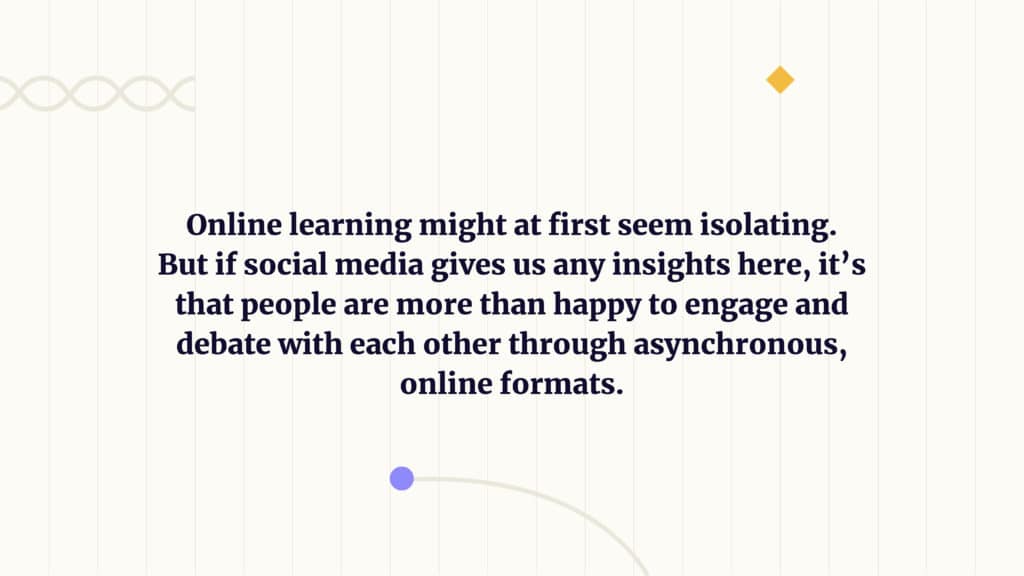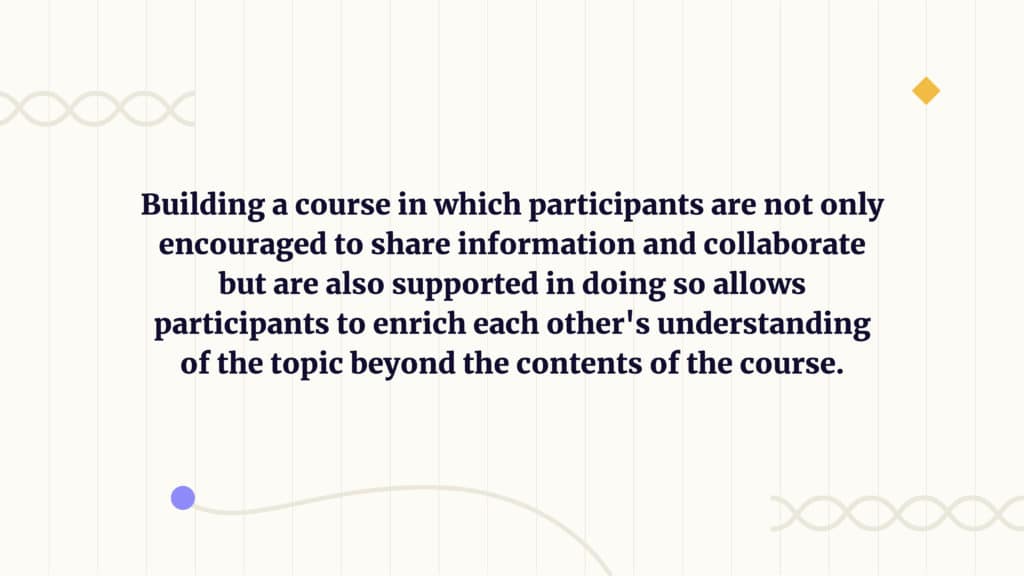A whole lot of elements go into designing the perfect online medical training experience – you know, the kind that achieves just what you set out to achieve, and does it effortlessly.
But while many of these elements might already be familiar, a lesser-known but vital element in a medical training program is a sense of collaboration. In this blog post, we explore why collaborative elements are essential to medical training and what we can do to encourage them in online medical training settings.
“Standing on the shoulders of giants” is essential rhetoric for professionals in the science and medicine communities. And it is especially true when it comes to the progress and development that these fields have witnessed over the years.
Of course, credit needs to be given to individual breakthrough discoveries and paradigm shifts. But when we look at the overall evolution of medicine and medical techniques, we can see a pattern, a common practice of incremental changes that build on the previous work of countless contributors.

In other words: for fields such as science and medicine, development of any kind emerges out of the shared community of knowledge that professionals in these fields possess. Moreover, it emerges out of their ability to effectively access and contribute to it.
A 2014 paper on the subject of ‘Knowledge Sharing Practices in the Healthcare Industry’ details the various forms of knowledge prevalent in the medical field ie. “medical knowledge, scientific knowledge, incident knowledge, and experience knowledge”.
But more crucially, it affirms that “delivering safe and high-quality services to patients” depends on not only acquiring but also “the sharing of these various types of knowledge” among medical professionals.
So with that said, it should come as no surprise that the role of collaboration when studying or training for a particular aspect within the medical field is a critical element for collective success.
With this in mind, how can online medical training programs best support this kind of inter-connected community-based knowledge creation, collaboration, and sharing?
Collaboration in Medical Trainings: What Works
Claned has been fortunate enough to have the opportunity to work with various different medical industry courses and training providers across the world – ranging from diabetes prevention and management in Africa to medicinal cannabis market trading in Germany. Not to mention various firms looking to make the most of new technologies in order to provide better care and patient information through devices and systems.
And in our experience, the one thing that has stood out as a common factor among all these is that they have all nudged, encouraged, and supported communication with peers during the course of their medical training programs.

This is in part because the organisations providing the medical training are well aware that the people taking the training are experts. They appreciate the fact that the learners in the program will have valuable insights to share and would be interested in expanding and developing their professional circles.
As such these organisations aim to not only share what they know, but also to learn from the learners and help them learn from each other. But to make this experience possible, the course provider must find creative ways to enable and support this kind of collaborative learning.
Building Collaborative Online Medical Training Programs
You might be wondering: so how exactly does this work in practice? And is there anything we can learn from these organizations to take into the next medical training and make it more collaborative?
Well, you’ll be glad to know that in practice, nothing these organizations do to bolster collaboration and interaction between learners is particularly fancy, specialist, or requiring boutique software.
Instead, it revolves largely around identifying opportunities to create communication and collaboration in medical training and maximising them. It’s all about providing the right kinds of instructions and support as well as setting clear expectations for learners.
Setting Clear Learner Expectations
Setting expectations for learners: here’s a process that is perhaps the easiest to implement, and yet one of the easiest to miss. And for good reason too. There is so much going on during the development and planning of a medical training program that setting clear expectations about how learners interact and collaborate with each other can easily fly under the radar.
In fact, for many course creators, these expectations might even fall under the category of “things that go without saying”. Which can be partly true, especially in face-to-face medical training environments (which most of us are used to) because there, these interactions happen organically. Someone says something aloud, it set off a thought or a reply in another person’s head and before you know it, a fruitful series of replies, debates, and elaborations is set off.

But with online medical trainings, where learners work relatively independently and at their individual computers, a feeling of isolation can set in. Which is why as course creators, it is our job to introduce another step into the process. Moreover, it is important to anticipate and answer simple learner questions like:
- “How do I reply to this?”
- “Will anyone even see this?”
- “Is it even worth my time to engage here?”
Online learning might at first seem isolating. But if social media gives us any insights here, it’s that people are more than happy to engage and debate with each other through asynchronous, online formats.

Of course, the difference between, say, Twitter and online medical training is that with the former, we know and expect reactions, comments, and interactions – that expectation is already set and accepted.
Similarly, when it comes to online medical training programs, simply setting your expectations about interactions, collaborations and communications (on the front page of the course, along with the syllabus – or better yet as a part of it) will accomplish a big step towards creating an active, social and collaborative learning environment.
How do you achieve that?
It can be as simple as adding a few sentences, such as:
- “Your peers are your fellow collaborators in this learning process, engage with them ask questions, and solve problems together.”
- “You are expected to comment on remarks and content and share resources and knowledge.”
- “Part of passing the course is dependent on your communication and collaboration with your peers.”
Integrating simple, encouraging statements like this into your online medical training experience will certainly go a long way in boosting a sense of collaboration in your program.
Priming Content for Collaboration
You can also foster a collaborative learning environment in your medical training with the right kind of content. And this is where, based on the options available to you, your efforts towards collaboration can really diversify.
To start with, there are a number of online tools and software that can help you create engaging learner activities and build content that is geared towards driving interaction and collaboration.

Another option is the inclusion of group projects – such as case studies or problem-solving cases – which provide perfect opportunities for learners to come together, share insights and collaborate.
However, even if you’re only working with simple forms of content such as videos and documents (the most common formats in online learning settings), it is still possible to provide support and guidance for deeper collaboration. This support can come primarily from the thoughtful inclusion of instructions and expectations for how learners should interact with the content.
A simple, low threshold way to encourage a more collaborative learning experience might be to routinely encourage questions and prompt debates and conversations related to an interesting topic or piece of content. And as a helpful tip, you can feature some introductory or guiding questions (that are sure to trigger conversations) into the instructions themselves.
Claned has a unique contextual commenting feature that makes collaborative activities such as these not only easy but also intuitive.
Just by opening up a piece of content, a learner can view the comments left on it and the questions and discussions taking place on its topic. Essentially, it effortlessly creates a dialogue or commentary that runs alongside the main content and is contextualised and relevant to whatever is being viewed.
Assembling Assignments for Medical Training
Of course, in a discussion of medical training experience, how can we forget assignments? But the more important question is: how do we make assignments more collaborative?
Of all the ideas for collaboration explored here, assignments are easily the highest threshold of effort. However, they can still be an easy, achievable practice with just one limiting factor: getting learners to study together at roughly the same time.

Basically, the trick here is to identify or include assignments or activities into the medical training that call for learners to problem solve and work together. Consider the example of case studies: while these are typically assigned individually, the program can also consider assigning them in groups. This means two things: more learners mean greater resources go into each assignment and with these greater resources, you can now also set the expectations of the deliverables higher.
Parting Words: Counting on Collaboration
Now let’s circle back to that essential question we started with: Why is collaboration among medical professionals important?
The answer is that much of the knowledge development and learning that takes place in the field of medicine is made possible only because studies, results, and advancements are openly and honestly shared. Building upon each other’s work is not only encouraged but expected.
This principle applies just as well to building online medical training programs. Whether learners are developing new treatments or simply learning how to use a new device, the collective knowledge pool is an essential element in medical education.
Further, as a course designer, while you may be well-versed in a specific niche or device, it’s unlikely that you are a consummate medical expert. Which is why building a course in which participants are not only encouraged to share information and collaborate but are also supported in doing so allows participants to enrich each other’s understanding of the topic beyond the contents of the course.

Above, we discussed some of the most important ways to approach this. But in more general terms, you can set up the ideal circumstances for collaboration simply by including instructions to ask and engage with peers and providing ample spaces for discussion.
Depending on the nature and topic of the medical training program, you might also consider assigning mentor roles to help guide participants along and build their professional networks. You could also include various guest lectures (either recorded or live) from experts and professionals in the field and even ask the guests to share their contact information.
Ultimately, the world of medical education and training is one that is primed for collaboration and one in which collaboration regularly does and must take place. Any medical training provided for professionals in the field should set expectations of regular communication between learners and foster learning environments in which collaboration is a natural and vital part of the training experience.







